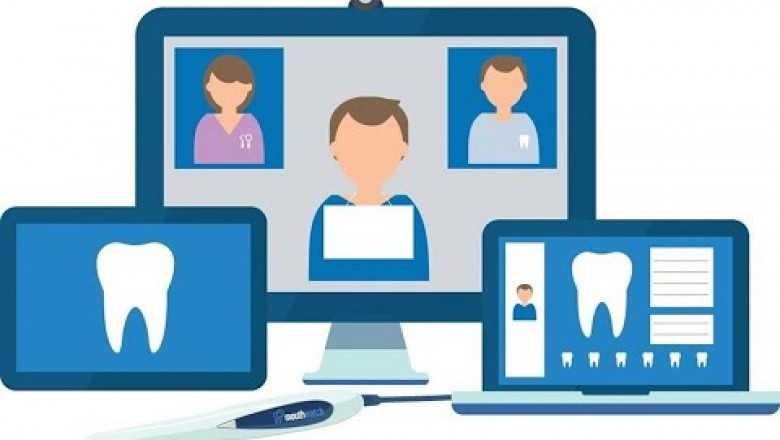views
What is Teledentistry?
Teledentistry refers to the use of telecommunication technology to provide oral healthcare services remotely. Through live video consultations, store-and-forward imaging, and other digital means teledentistry enables dentists to provide diagnosis, treatment planning, and other dental services without being physically present. This emerging field has the potential to significantly expand access to quality dental care, especially for underserved populations in rural and remote areas.
Benefits of Teledentistry
Teledentistry offers several key benefits over traditional face-to-face care:
Convenience for Patients
No need for patients to take time off work or arrange transportation for routine dental checks or follow-ups. Teledentistry consultations can take place from the comfort of patients' own homes or workplaces via computer or mobile devices. This convenience factor helps improve engagement with dental care.
Expanded Access in Underserved Areas
Rural and remote communities often struggle with severe dental provider shortages. Teledentistry helps bridge this gap by allowing dentists in urban areas to treat patients remotely in underserved communities. This model has significantly improved access to dental expertise in areas that previously had none.
Cost Savings
By reducing the need for travel and facility overhead, teledentistry consultations are more affordable for both patients and providers. This cost-effectiveness will be crucial for teledentistry models to achieve sustainability over the long term.
Public Health Benefits
More widespread dental screenings and consultations through teledentistry can help catch cavities and other issues earlier when treatment is less invasive and less costly. This translates to overall savings in urgent and emergency dental procedures down the line.
Teledentistry Solutions
A variety of teledentistry solutions exist to support different types of remote dental care delivery:
Store-and-Forward Consultations
High-quality photos or X-rays of the dental issue are taken by the dental professional or patient and securely transmitted to an consulting dentist for evaluation and treatment recommendations. This asynchronous model is well-suited for screenings, referrals, and post-op follow-ups that don't require real-time interaction.
Live Video Consultations
Remote dental exams can be performed in real time through live audio-video connections between patient and practitioner. Using special video dental cameras, the dentist can visually inspect the mouth to diagnose conditions and guide treatment as needed from afar.
Remote Monitoring Technologies
Advancements allow monitoring of things like alignment in orthodontic treatment or recovery from oral surgeries without physical checkups. Sensors and apps transmit data securely to facilitate remote oversight by dental specialists.
Mobile Teledentistry
Portable devices like smartphones and tablets equipped with cameras enable teledentistry from practically any location via wireless internet. This offers added flexibility for underserved communities and emergency responders in remote contexts.
Teledentistry Models of Care
With enabling technology, teledentistry can support different models for remotely delivering dental services:
Dental Consultations
General dentists refer complex cases requiring specialized expertise to remote dental specialists for virtual consultations and treatment coordination via teledentistry.
Dental Home Model
Home-based primary dental care is enabled through regular remote screenings and maintenance conducted via teledentistry by a designated dental home, with in-person treatment arranged as needed.
Dental Emergency Triage
Remote dental triage helps determine the most appropriate level of care (self-care, primary care, or emergency services) needed for things like dental trauma in areas far from brick-and-mortar clinics.
Remote Dental Practices
Dentists based in one location use teledentistry to fully treat patients living far away, as primary providers. Supported by local non-dental assistants for tasks like taking X-rays under remote guidance.
Regulatory Challenges and Future Directions
While teledentistry holds immense promise, wider adoption faces challenges around licensure, reimbursement models, and internet infrastructure in underserved regions that will require coordinated efforts across policy and technology spheres to fully address. Licensing requirements are now evolving to encompass remote multi-state practice enabled by modern connectivity. And emerging regional studies assessing teledentistry's impacts on access, costs and oral health outcomes will guide strategic rollouts. Teledentistry's potential to transform access globally remains bright if these challenges are met with collaborative solutions that recognize dentistry's evolution in the digital healthcare landscape.
Get this Report in Japanese Language:
Get this Report in Korean Language:
About Author:
Money Singh is a seasoned content writer with over four years of experience in the market research sector. Her expertise spans various industries, including food and beverages, biotechnology, chemical and materials, defense and aerospace, consumer goods, etc. (https://www.linkedin.com/in/money-singh-590844163)






















Comments
0 comment